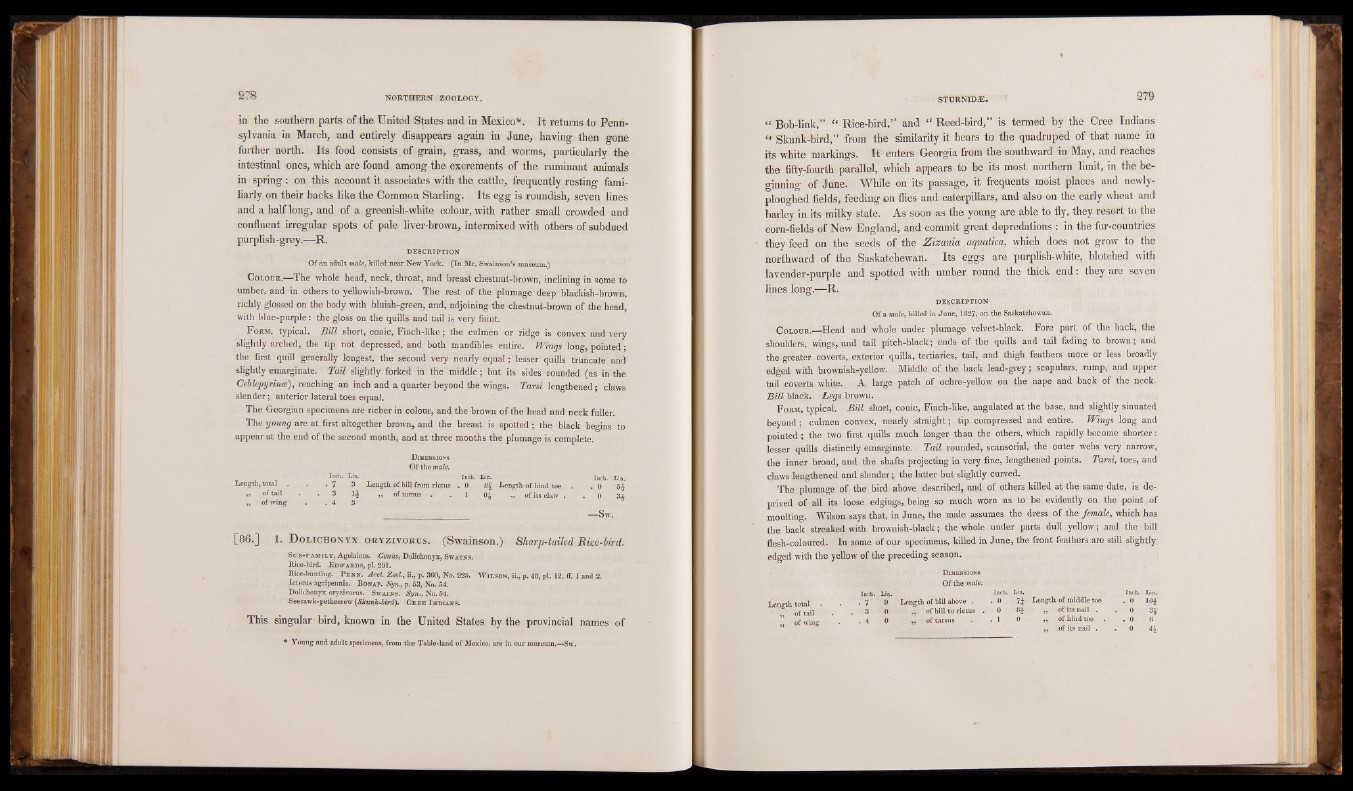
in the southern parts of the United States and in Mexico*. It returns to Penn-
sylvania in March, and entirely disappears again in June, having then gone
further north. Its food consists of grain, grass, and worms, particularly the
intestinal ones, which are found among the excrements of the ruminant animals
in spring: on this account it associates with the cattle, frequently resting familiarly
on their backs like the Common Starling. Its egg is roundish, seven lines
and a half long, and of a greenish-white colour, with rather small crowded and
confluent irregular spots of pale liver-brown, intermixed with others of subdued purplish-grey.—R.
DESCRIPTION
Of an adult male, killed near New York. (In Mr. Swainson’s museum.)
Colour.—The whole head, neck, throat, arid breast chestnut-brown, inclining in some to
umber, and in others to yellowish-brown. The rest of the plumage deep blackish-brown,
richly glossed on the body with bluish-green, and, adjoining the chestnut-brown of the head,
with blue-purple-: the gloss on the quills and tail is very faint.
Form, typical. Bill short, conic, Finch-like; the culmen or ridge is convex and very
slightly arched, the tip not depressed, and both mandibles entire. Wings long, pointed;
the first quill generally longest, the second very nearly equal; lesser quills truncate and
slightly emarginate. Tail slightly forked in the middle; but its sides rounded (as in the
Ceblepyrince), reaching an inch and a quarter beyond the wings. Tarsi lengthened; claws
slender; anterior lateral toes equal.
The Georgian specimens are richer in colour, and the brown of the head and neck fuller.
The young are at first altogether brown, and the breast is spotted ; the black begins to
appear at the end of the second month, and at three months the plumage is complete.
Dimensions
Of the male.
Length, total Inch. Lin.
» 7 3 Length of bill from rictus Inch. Lin.
. „ . of tail 0 8i Length of hind toe . 0 • 3 ,, of tarsus . 1 0* ,, of its daw . . 0 „ of wing . . 4 3
—Sw.
[86-]-' 1. D o l i c h o n y x o r y z iv o r u s . (Swainson.) Sharp-tailed Rice-bird.
Stjb-fa m il y , Agelainaa. Genus, Dolichonyx, Sw ain s.
Rice-bird. E dwa rds, pi. 291.
Rice-bunting. P e r u . Arot. Zool., ii, p. 360, No. 226. W il so n , ii., p. 48, pi. 12, ff. 1 and 2. Icterus agripennis. B onap. Syn., p. 53, No. 54.
Dolichonyx oryzivorus. Swains. Syn., No. 54.
Seecawk-petheesew (Skunk-bird). Gb.e e I ndians.
This, singular bird, known in the United States by the provincial names of
* Young and adult specimens, from the Table-land of Mexico, are in our museum.—Sw.
Bob-link,” “ Rice-bird,” and “ Reed-bird/’ is termed by the Cree Indians
I Skunk-bird,” from the similarity it bears to the quadruped of that name in
its white markings. It enters Georgia from the southward in May, and reaches
the fifty-fourth parallel, which appears to be its most northern limit, in the beginning
of June. While on its passage, it frequents moist places and newly-
ploughed fields, feeding on flies and caterpillars, and also on the early wheat and
barley in its milky state. As soon as the young are able to fly, they resort to the
corn-fields of New England, and commit great depredations : in the fur-countries
they feed on the seeds of the Zizania aqualica, which does not grow to the
northward of the Saskatchewan. Its eggs are purplish-white, blotched with
lavender-purple and spotted with umber round the thick end: they are seven
lines long.;—R.
DESCRIPTION
Of a male, killed in June, 1827, on the Saskatchewan.
Colour.__Head and whole under plumage velvet-black. Fore part of the back, the
shoulders, wings, and tail pitch-black; ends of the quills and tail fading to brown; and
the greater coverts, exterior quills, tertiaries, tail, and thigh feathers more or less broadly
edged with brownish-yellow. Middle of the back lead-grey; scapulars, rump, and upper
tail coverts white. A large patch of ochre-yellow on the nape and back of the neck.
Bill black. Legs brown.
Form, typical. Bill short, conic, Finch-like, angnlated at the base, and slightly sinuated
beyond ; culmen convex, nearly straight; tip compressed and entire. Wings long and
pointed ; the two first quills much longer than the others, which rapidly become shorter:
lesser quills distinctly emarginate. Tail rounded, scansorial, the outer webs very narrow,
the inner broad, and the shafts projecting in very fine, lengthened points. Tarsi, toes, and
claws lengthened and slender; the latter but slightly curved.
The plumage of the bird above described, and of others killed at the same date, is deprived
of all its loose edgings, being so much worn as to be evidently on the point of
moulting. Wilson says that, in June, the male assumes the dress of the female, which has
the back streaked with brownish-black; the whole under parts dull yellow; and the bill
flesh-coloured. In some of our specimens, killed in June, the front feathers are still slightly
edged with the yellow of the preceding season.
Dimensions
Of the male.
Inch. Lin. . I“?1»- Lin- Inch. Wn» Length total . . . 7 9 Length of bill above . . 0 7± Length of middle toe . 0 10±
- ° Gf tail . . 3 0 • „ of bill to rictus . 0 8£ ,, of its nail . . 0
”” 0f wing . . 4 0 „ of tarsus . . 1 0 „ ooff hitisn nda tiole . . . . 00 6 4§